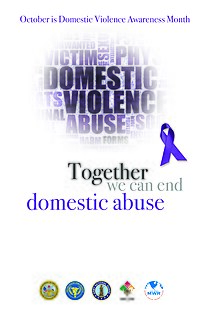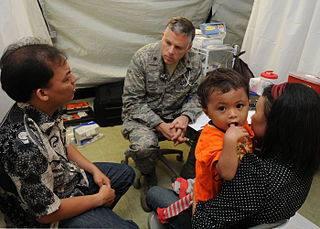Related Research Articles
Occupational therapists (OTs) are health care professionals specializing in occupational therapy and occupational science. OTs and occupational therapy assistants (OTAs) use scientific bases and a holistic perspective to promote a person's ability to fulfill their daily routines and roles. OTs have immense training in the physical, psychological, and social aspects of human functioning deriving from an education grounded in anatomical and physiological concepts, and psychological perspectives. They enable individuals across the lifespan by optimizing their abilities to perform activities that are meaningful to them ("occupations"). Human occupations include activities of daily living, work/vocation, play, education, leisure, rest and sleep, and social participation.

Occupational therapy (OT) is a global healthcare profession. It involves the use of assessment and intervention to develop, recover, or maintain the meaningful activities, or occupations, of individuals, groups, or communities. It is an independent health profession sometimes categorized as an allied health profession and consists of occupational therapists and occupational therapy assistants (OTA). OTs often work with people with mental health problems, disabilities, injuries, or impairments.
In Australia, Diversional Therapy “is a client centred practice [that] recognises that leisure and recreational experiences are the right of all individuals.” Diversional Therapists promote the involvement in leisure, recreation and play by reducing barriers to their client's participation and providing opportunities where the individual may choose to participate. Ideally these recreational activities promote self-esteem and personal fulfillment, through an emphasis on holistic care; providing physical, psychological, social, intellectual and spiritual/cultural support.

Social exclusion or social marginalisation is the social disadvantage and relegation to the fringe of society. It is a term that has been used widely in Europe and was first used in France in the late 20th century. It is used across disciplines including education, sociology, psychology, politics and economics.
Occupational science is a discipline dedicated to the study of humans as "doers" or "occupational beings". As used here, the term "occupation" refers to the intentional or goal-directed activities that characterize daily human life as well as the characteristics and patterns of purposeful activity that occur over lifetimes.
According to the American Therapeutic Recreation Association (ATRA), recreational therapy or therapeutic recreation (TR) is a systematic process that utilizes recreation (leisure) and other activities as interventions to address the assessed needs of individuals with illnesses and/or disabling conditions, as a means to psychological and physical health, recovery and well-being. Recreational therapy may also be simply referred to as recreation therapy, in short it is the utilization and enhancement of leisure.
The Canadian Model of Occupational Performance and Engagement (CMOP-E) was developed by the Canadian Association of Occupational Therapists in 1997, and describes transactions and mutual influences between the dimensions of occupational performance It is applied by the accompanying Occupational Performance Process Model, which describes the therapeutic process from a client’s perspective The main model illustrates the relationship between person, occupation and environment. Spirituality is the fourth dimension, placed in the centre of the model to highlight its fundamental importance.
Occupational rehabilitation is the science and practices of returning injured workers to a level of daily work activities that is appropriate to their functional and cognitive capacity related to their position of which may be influenced by the severity of a worker's injuries.
Occupational apartheid is the concept in occupational therapy that different individuals, groups and communities can be deprived of meaningful and purposeful activity through segregation due to social, political, economical factors and for social status reasons.
This article discusses occupational therapy (OT) in the United Kingdom.
Social deprivation is the reduction or prevention of culturally normal interaction between an individual and the rest of society. This social deprivation is included in a broad network of correlated factors that contribute to social exclusion; these factors include mental illness, poverty, poor education, and low socioeconomic status.
Feminist psychology is a form of psychology centered on social structures and gender. Feminist psychology critiques historical psychological research as done from a male perspective with the view that males are the norm. Feminist psychology is oriented on the values and principles of feminism.
Social engagement refers to one's degree of participation in a community or society.

The management of domestic violence deals with the treatment of victims of domestic violence and preventing repetitions of such violence. The response to domestic violence in Western countries is typically a combined effort between law enforcement, social services, and health care. The role of each has evolved as domestic violence has been brought more into public view.
Occupational Therapy is used to manage the issues caused by seasonal affective disorder (SAD). Occupational therapists assist with the management of SAD through the incorporation of a variety of healthcare disciplines into therapeutic practice. Potential patients with SAD are assessed, treated and evaluated primarily using treatments such as drug therapies, light therapies, and psychological therapies. Therapists are often involved in designing an individualised treatment plan that most effectively meets the client's goals and needs around their responsiveness to a variety of treatments.

Cultural competence in healthcare refers to the ability for healthcare professionals to demonstrate cultural competence toward patients with diverse values, beliefs, and feelings. This process includes consideration of the individual social, cultural, and psychological needs of patients for effective cross-cultural communication with their health care providers. The goal of cultural competence in health care is to reduce health disparities and to provide optimal care to patients regardless of their race, gender, ethnic background, native languages spoken, and religious or cultural beliefs. Cultural competency training is important in health care fields where human interaction is common, including medicine, nursing, allied health, mental health, social work, pharmacy, oral health, and public health fields.
Substance use disorders (SUD) can have a significant effect on one’s function in all areas of occupation. Physical and psychosocial issues due to SUD can impact occupational performance. Unfulfilled life roles and disruption in meaningful activity can result from lack of structure or routine, poor motivation, limited skills, and poor social networks. These deficits may also contribute to stress, affecting the ability to cope with challenges. While SUD can affect a client’s participation in therapy and ability to follow recommendations, occupational therapists are trained to facilitate occupational participation and performance.
The goal of physical and occupational therapy in Duchenne muscular dystrophy is to obtain a clear understanding of the individual, of their social circumstances and of their environment in order to develop a treatment plan that will improve their quality of life. Individuals with DMD often experience difficulties in areas of self-care, productivity and leisure. This is related to the effects of the disorder, such as decreased mobility; decreased strength and postural stability; progressive deterioration of upper-limb function; and contractures. Occupational and physical therapists address an individual's limitations using meaningful occupations and by grading the activity, by using different assessments and resources such as splinting, bracing, manual muscle testing (MMT), ROM, postural intervention and equipment prescription.
Occupational justice is a particular category of social justice related to the intrinsic need for humans to explore and act on their environments in ways that provide healthy levels of intellectual stimulation, and allow for personal care and safety, subsistence, pleasure, and social participation.
Currently there is no cure for Rett syndrome. Treatment is directed towards improving function and addressing symptoms throughout life. A multi-disciplinary team approach is typically used to treat the person throughout life. This team may include primary care physician, physical therapist, occupational therapist, speech-language pathologist, nutritionist, and support services in academic and occupational settings.
References
- ↑ Stadnyk, Robin L., Townsend, Elizabeth A, & Wilcock, Ann A. (2010). Occupational justice. In Christiansen, C.H. & Townsend, E.A.(Eds). Introduction to Occupation-The Art and Science of Living. Upper Saddle River, NJ: Pearson.(pp. 329-358).
- 1 2 3 4 Simó-Algado, S., Mehta, N., Kronenberg, F., Cockburn, L., & Kirsh, B. (2002). Occupational therapy intervention with children survivors of war. Canadian Journal of Occupational Therapy, 69(4), 205-217.
- 1 2 3 4 5 Whiteford, G. (2000). Occupational deprivation: Global challenge in the new millennium. British Journal of Occupational Therapy, 63(5), 200-204.
- ↑ Hammell, K. R. W., & Iwama, M. K. (2012). Well-being and occupational rights: An imperative for critical occupational therapy. Scandinavian Journal of Occupational Therapy, 19(5), 385-394.
- ↑ Alexander, B. K. (2008). The globalisation of addiction: A study in poverty of the spirit. Oxford University Press.
- 1 2 3 4 5 6 Townsend, E., & Wilcock, A. A. (2004). Occupational justice and client-centred practice: A dialogue in progress. Canadian Journal of Occupational Therapy, 71(2), 75-87.